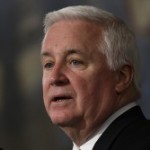Corbett endorses Tobash pension plan, but savings could be iffy

By Eric Boehm | PA Independent
The effort to fix Pennsylvania’s pension problems got a boost from Gov. Tom Corbett on Wednesday, but there are still lots of questions about whether the effort will save the state much money.
Corbett announced his support for the bill sponsored by state Rep. Mike Tobash, R-Schuylkill, which would create a new pension system for future hires with lower benefits and a different structure. The Corbett administration had been working with Tobash and other Republican leaders in the General Assembly for months to craft the plan.
PENSION REFORM: Corbett says pension reform is important because saving money on pension costs means more money for things like education.
“Pension costs continue to erode our ability to pay for important, necessary programs and services for Pennsylvanians,” Corbett said in the statement. “Every dollar saved through pension reform is a dollar that can be invested in our students, in our classrooms and throughout our school districts across the commonwealth.”
Corbett has been hesitant to issue such public support for legislation throughout his first term, so Wednesday’s comments are an indication of just how important the pension issue is for the governor and his team.
And the governor’s statement reveals that creating savings by reconfiguring the pension system is the most critical piece of the equation — indeed, that’s the real reason why any lawmaker in Harrisburg is interested in the pension situation.
Pennsylvania has more than $50 billion in pension debt, a figure that will grow to more than $65 billion within a few more years.
An actuarial analysis of the bill found potentially $11 billion in savings over the next 30 years, with most of the savings coming in the later stages.
That number is hardly written in stone. There are several things that could happen — independent of the pension bill itself — to reduce the expected savings over the next three decades.
The most likely is that the two pension funds — the State Employees Retirement System and the Public School Employees Retirement System — will decide to lower their expected annual rates of return.
Both funds are currently working off the assumption investments will earn 7.5 percent or more each year. Historically, they have been able to hit that mark, but there is a growing consensus that pension funds’ targets should be lowered to make the funds less exposed to risk and volatility in the market.
Cherion, one of the firms that conducted the actuarial analysis of Tobash’s bill, recently told Rhode Island there was only a 40 percent chance its pension funds would be able to earn 7.5 percent annually for the next two decades.
But the National Society of Actuaries advises pension funds to use expected rates of return “they believe can be achieved over the next 20- to 30-year period with a 50 percent probability.”
TOBASH: State Rep. Mike Tobash says his proposal is a first step towards solving the pension crisis.
To get to 50 percent probability, Cherion told Rhode Island it would have to lower its expectations to 7 percent annually.
“These things should be done conservatively so the retirees know what they will have,” said Robert Pozen, a professor at Harvard Business School and senior fellow for the Brookings Institution, a nonpartisan think tank. “You don’t want to create an incentive for politicians to underfund the plans.”
Pennsylvania happens to use a 7.5 percent assumption right now. The boards for SERS and PSERS review the expectations each year, and though they say there are no current plans to lower the expectations, it is always a possibility for the future.
Cherion even suggested as much in its analysis of Tobash’s bill.
“What is becoming increasingly apparent among public plans is the inability to respond to the risk volatility of the underlying investments backing the benefit promises,” the actuaries wrote, adding that Pennsylvania should aim to “lower the overall risk profile” of its pension plans by decreasing the assumed annual returns.
The problem: each time the assumed rate of return is decreased, it cuts into those projected future savings in Tobash’s bill.
In 2010, Pennsylvania approved a series of pension changes that promised to save the state $3 billion over the next few decades.
A year later, both PSERS and SERS reduced their expected rates of return to the current 7.5 percent from 8 percent. The result was the addition of about $6 billion in future costs.
“It wiped out more than twice the 30-year cumulative savings, overnight,” said Rick Dreyfusss, a retired actuary and pension expert with the Manhattan Institute, a fiscally conservative think tank.
If the funds were to lower their assumptions to 7 percent — in line with the Society of Actuaries and Cherion’s recommendations — it could vaporize more than half the expected savings over the next 30 years.
Of course, all that is a hypothetical scenario. But it’s a pretty likely hypothetical, given the national trend of pension funds lowering their expected rates of return in the years since the economic downturn.
Tobash acknowledges his bill isn’t the final solution to Pennsylvania’s pension trouble, but he and other supporters effort say it’s a worthwhile first step.
“The cost of doing nothing grows larger every day this issue is left unaddressed,” Tobash said Wednesday.
Meanwhile, lawmakers and groups on the political left have assailed Tobash’s bill for reducing future state workers’ retirement security by scaling back benefits.
But the goal among most policymakers in Harrisburg is to find a solution that saves the state money — a natural reaction to staring at $50 billion in debt that must be paid.
Tobash says his bill can save the state money, but there are lots of big “ifs” about it.
Boehm is a reporter for PA Independent and can be reached at Eric@PAIndependent.com. Follow @PAIndependent on Twitter for more.







